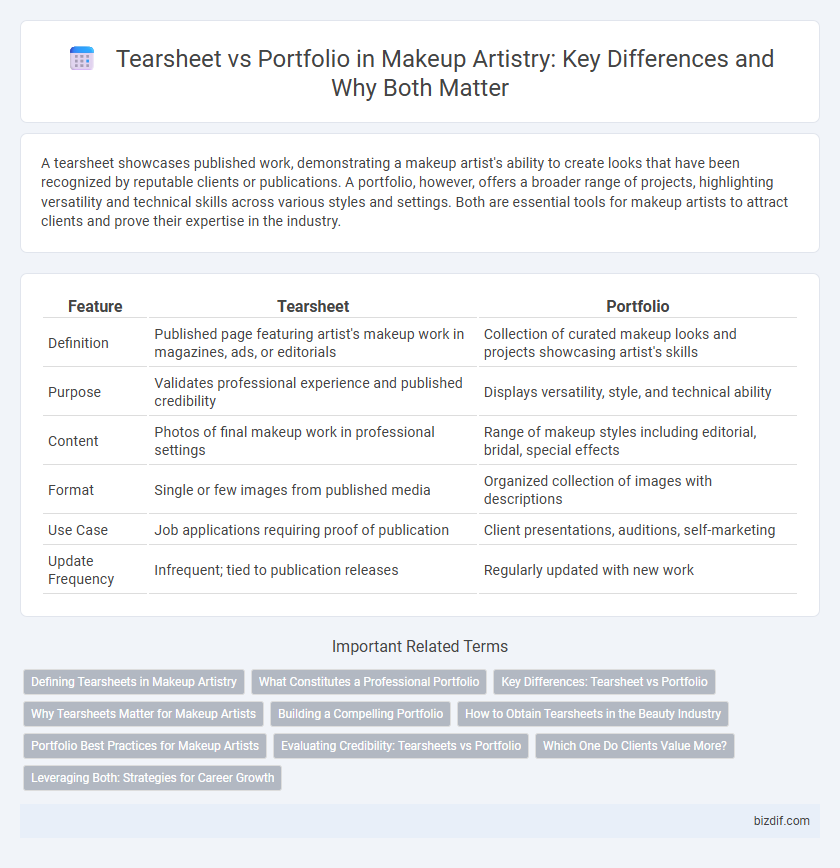A tearsheet showcases published work, demonstrating a makeup artist's ability to create looks that have been recognized by reputable clients or publications. A portfolio, however, offers a broader range of projects, highlighting versatility and technical skills across various styles and settings. Both are essential tools for makeup artists to attract clients and prove their expertise in the industry.
Table of Comparison
| Feature | Tearsheet | Portfolio |
|---|---|---|
| Definition | Published page featuring artist's makeup work in magazines, ads, or editorials | Collection of curated makeup looks and projects showcasing artist's skills |
| Purpose | Validates professional experience and published credibility | Displays versatility, style, and technical ability |
| Content | Photos of final makeup work in professional settings | Range of makeup styles including editorial, bridal, special effects |
| Format | Single or few images from published media | Organized collection of images with descriptions |
| Use Case | Job applications requiring proof of publication | Client presentations, auditions, self-marketing |
| Update Frequency | Infrequent; tied to publication releases | Regularly updated with new work |
Defining Tearsheets in Makeup Artistry
Tearsheets in makeup artistry are published samples of an artist's work featured in magazines, advertisements, or online editorials, serving as credible proof of their professional experience. They highlight real-world applications and industry recognition, showcasing the artist's ability to meet commercial and editorial standards. Unlike portfolios, tearsheets emphasize published visibility and third-party validation, making them essential for demonstrating market success to potential clients or employers.
What Constitutes a Professional Portfolio
A professional makeup artistry portfolio consists of high-quality images showcasing a diverse range of styles, techniques, and subjects to demonstrate versatility and expertise. It typically includes well-lit, close-up shots highlighting skin texture, color blending, and contouring, as well as full-face looks that illustrate creativity and trend awareness. A comprehensive portfolio also features client testimonials and details about the makeup products used, establishing credibility and professionalism in the industry.
Key Differences: Tearsheet vs Portfolio
A tearsheet is a published image showcasing a makeup artist's work, usually clipped from magazines or advertisements, serving as proof of real-world professional experience. A portfolio, however, is a curated collection of diverse images, including editorial shoots, client makeovers, and test runs, designed to demonstrate the artist's range, creativity, and technical skills. While tearsheets validate published success, portfolios provide a comprehensive overview of an artist's capabilities and style.
Why Tearsheets Matter for Makeup Artists
Tearsheets hold significant value for makeup artists as they provide tangible proof of published work, showcasing their skills in real editorial contexts. Unlike portfolios, which often contain curated images with ideal lighting and settings, tearsheets demonstrate an artist's experience working with professional teams under diverse conditions. These published proofs build credibility and attract potential clients by validating the artist's ability to meet industry standards.
Building a Compelling Portfolio
Building a compelling makeup artistry portfolio involves showcasing diverse looks, high-quality images, and the artist's unique style to attract potential clients and employers. Unlike a tearsheet, which features published work in magazines or media, a portfolio serves as a comprehensive visual resume highlighting the artist's skills and creativity across various projects. Consistently updating the portfolio with fresh, relevant work ensures it remains an effective tool for career advancement in the competitive makeup industry.
How to Obtain Tearsheets in the Beauty Industry
Obtaining tearsheets in the beauty industry involves collaborating with magazines, websites, or advertising campaigns to feature your makeup artistry work in published editorials or advertisements. Makeup artists can secure tearsheets by building relationships with photographers, stylists, and editors, submitting strong work samples, and participating in professional photo shoots or beauty campaigns. Networking at industry events and maintaining a professional online presence increases opportunities for securing published materials that serve as credible proof of expertise and work quality.
Portfolio Best Practices for Makeup Artists
A well-crafted portfolio showcases a makeup artist's versatility, highlighting diverse looks from natural to avant-garde with high-quality, close-up images that emphasize technique and creativity. Organizing work thematically or by occasion, such as bridal, editorial, or special effects, helps potential clients and employers navigate your expertise efficiently. Regularly updating the portfolio with recent projects and including client testimonials or behind-the-scenes shots elevates credibility and demonstrates ongoing professional growth.
Evaluating Credibility: Tearsheets vs Portfolio
Tearsheets serve as tangible proof of a makeup artist's published work, showcasing their ability to meet editorial standards and work with high-profile clients, which enhances their credibility in the fashion industry. A portfolio offers a broader scope, featuring diverse styles and techniques that demonstrate versatility and creativity, essential for attracting a wide range of clients. Evaluating credibility involves balancing the tangible validation that tearsheets provide with the comprehensive visual narrative found in an artist's portfolio.
Which One Do Clients Value More?
Clients in makeup artistry tend to value portfolios more than tearsheets because portfolios provide a comprehensive, curated collection of an artist's skills, styles, and versatility. Portfolios showcase original work and offer deeper insight into the artist's range, creativity, and ability to execute different looks. Tearsheets, often used for advertising or editorial purposes, serve as proof of published work but may not fully represent the makeup artist's overall capabilities.
Leveraging Both: Strategies for Career Growth
Maximizing career growth in makeup artistry involves leveraging both a tearsheet and a portfolio effectively. A tearsheet showcases published work in high-profile magazines or campaigns, validating professional credibility, while a portfolio provides a comprehensive display of versatility and technical skills across various projects. Combining these tools enhances visibility, attracts diverse clients, and demonstrates both experience and artistic range to potential employers and collaborators.
Tearsheet vs Portfolio Infographic

 bizdif.com
bizdif.com